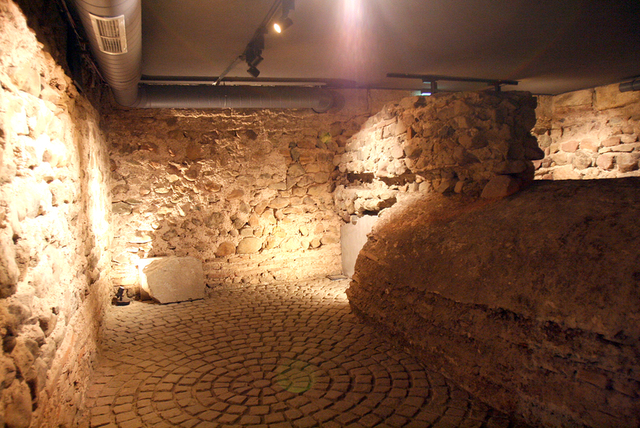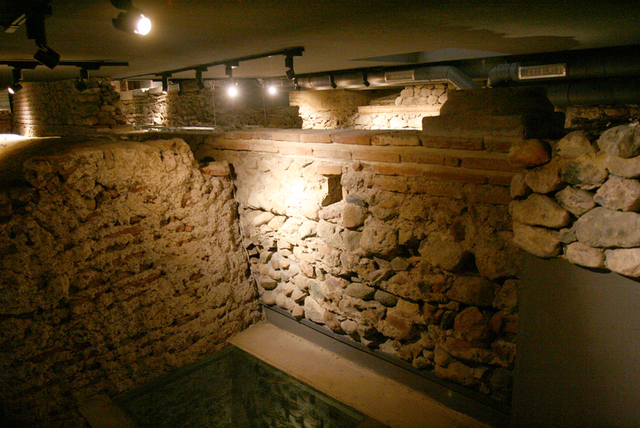Basilica Sveta Sofia - Sofia city
The Early Christian basilica Sveta Sofia is an active Orthodox church in the center of Sofia city. It is adjacent to the memorial church Sveti Alexander Nevski.
History and Architecture
The church was probably built in the early VI century on the ruins of Christian tombs from II - IV century and the ruins of two earlier churches from IV-V century. It is located among the necropolis of the Ancient Serdika, which stretched east from the city citadel, ie from today's Council of Ministers to Tsaritsa Yoana hospital.
Sofia's history is closely connected with the temple Sveta Sofia, which like the eponymous church in Constantinople is dedicated to the "Wisdom of God" - one of the names of the young Jesus Christ. That, and not the emanating name of martyr Sofia, became the name of the city from ХІV century onwards. The temple is the most ancient sacred in the city, built at its highest at that time part.
The first early Christian church was built probably in the early IV century, not far from the scene of the ancient Serdika where Christian martyrs were killed, among the eastern pagan and Christian necropolis of the city. It is assumed that is intended to be a martirium (a chapel of the martyrs tomb) or a cemetery church.
Later in the same place was built a new church, which was enlarged and its floor was decorated with Roman mosaics. Many of these mosaics are preserved in nowadays.
Till VI century in the building have been done lots of changes and basic reconstruction. In the middle of the century the church was severely damaged by the invasions of the Huns and Goths and Emperor Justinian the Great ordered to rebuild it again as large basilica dedicated to "the Wisdom of God."
The church is a cross basilica with narthex, three ships and three-sided apse.
It is assumed that its architecture is a result of Georgian influence of imperial and construction leaders.
After 809, when khan Krum included Serdika into the territories of Bulgaria, especially after the conversion and during the Bulgarian Middle Ages, the church continued to be actively used as a fair church and common burial place, due to its proximity of the city cemetery. At the time of the Second Bulgarian Kingdom (XII - XIV century), it acquires the status of bishop's cathedral church.
After the Ottoman invasion the basilica was converted into a mosque - minarets were built and unique paintings were destroyed (found traces of such from XII century preceding those in the Boyana Church). Probably due to an earthquake in the middle of XV century the building was destroyed for the first time. At the end of the XVI century it was rebuilt as a mosque by the Ottoman Grand Vizier of Croatian origin Siyavush pasha.
In 1818 and again in 1858 the building suffered severely from strong earthquakes - the minaret fell and among the Turks rumoured that they made the Christian God angry, and the mosque was finally abandoned. The survived part was converted into a warehouse used as such until the Liberation, when on the 4th of January 1878 the Russian troops of General Gurko were met with a thanksgiving service.
Nowadays the church has no bell tower. The bell hang on a tree in the garden in front. It is said that this is a tribute, as the bell is right there where it was at the meeting of the liberation forces.
Modern reconstruction
At the end of the XIX century, the building was briefly used as a watchtower of the metropolitan fire brigade. The first modern restoration and reconstruction of the temple was completed in 1930. On 21 September in the same year the church was consecrated. In 1935 was performed a systematic study and restoration under the direction of Professor Bogdan Filov and architect Alexander Rashenov. In 1955 the church was declared a cultural monument.
Currently, the church was rebuilt as a three-aisled cross basilica with three massive altar. The church rituals in choosing the Bulgarian patriarchs in modern times are associated with this ancient temple.
Archaeological studies continually reveal new aspects of Christian antiquity, preserved there. In the 80s and 90s years of last century, when the church was again restored to the image closest to the late antique and medieval original on the southern wall was built the main official memorial to the Republic of Bulgaria - the Monument of the Unknown Soldier ("The Eternal fire"). Then most unexpectedly were found several tombs and catacombs underneath and in close vicinity of the church. This initiates an architectural history project for detailed study, restoration and exhibition of the Christian religious complex.
Underground Museum
By the end of 2013 will be open an unique museum beneath the basilica, which will reveal 41 tombs and over one hundred burial structures from different periods between I-V century. Will be shown about 70 sq m fully preserved colorful mosaic from III - IV century, which will be placed precisely in the places where it was located. The museum complex will be on two levels with a height of 6 m entirely underground. On the first level will be displayed the mosaic, and on the second - the tombs. The museum will have multimedia. The entire area will be 1400 sq m. This is one of the projects by which Sofia will apply for inclusion in the World Heritage List of UNESCO.
The Basilica Sveta Sofia is among the most important architectural values from the early Christianity in Southeast Europe with worldwide reach.
In the garden on the east side of the church is buried the writer Ivan Vazov.
Transport and accommodation
The convenient location of the church in the heart of the city makes it easily accessible by public transport.
Hours:
Summer - from 10.00 to 18.00 /every day/
Winter - from 10.00 to 17.00 /Monday day off/
Sofia city offers a large choice of hotels and rooms to rent.
Sources: http://bg.wikipedia.org/, http://svetimesta.com/, http://www.nasamnatam.com/, http://info-sofia.bg/
Photos: http://bg.wikipedia.org/, http://vijsofia.eu/













